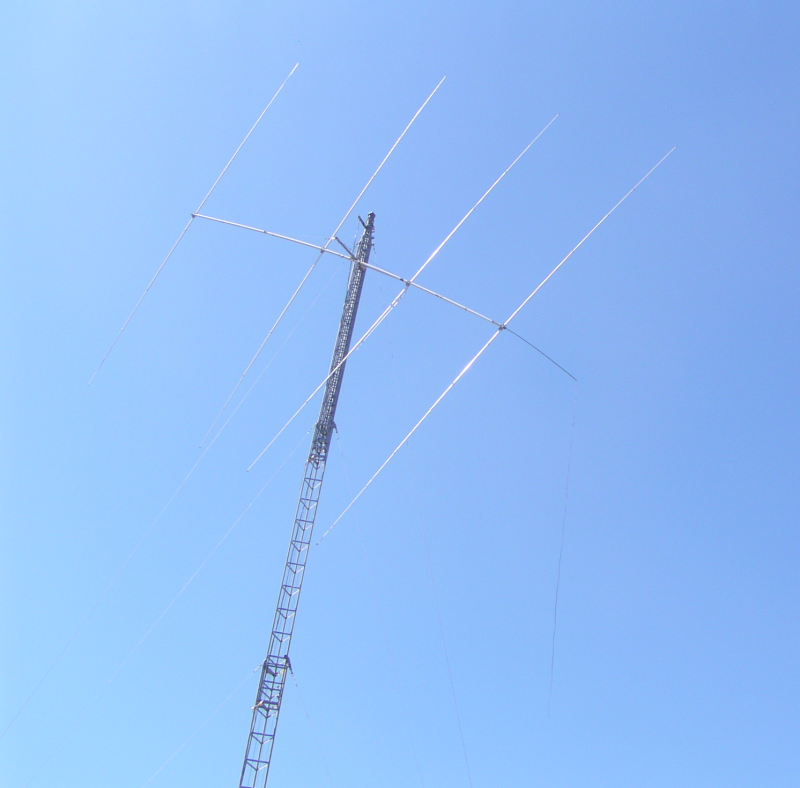Hy-Gain (CDE) Rotor
Lessons Learned the Hard Way
I have used Ham series rotors for over 30 years now, sometimes to turn
some pretty big antennas. These rotors are usually fairly
inexpensive used (at least as rotors go), and if you don't have a large
budget,
you can make them work, provided you are careful to avoid some of their
pitfalls. I admit to learning all of these lessons the hard
way, and I'm ashamed of the number of years and re-occurrences it took
me to learn some of them. I have listed some here, and if you
have others, I would
like
to hear about them.
Some Ham Series Hints
- If you want to turn a big antenna, I believe it is worth it
to convert your Ham series rotor into a Ham IV if it
isn't already one. The folks at C.A.T.S. and Norm's Rotor Service
are helpful with this. They can help you figure out what
parts you need to do the conversion. The Ham IV has a better
brake
housing
and wedge, a better ring gear, and a better limit switch stop.
The Tailtwister has issues with getting stuck, and the cost
to convert a Ham IV to a T2X isn't worth it in my opinion.
The gearbox is the same; the housing is beefier, but
I believe that the main advantage is that the bolts go through the
housing, so the housing is more securely held together than in the
standard Ham IV. I found another solution to the problem of
loose bolts holding the housing together.
- The super
wedge is an improved brake wedge sold by C.A.T.S. and
is well worth installing.
- Never let your antenna coast to a halt at the south stop.
This ruins the limit switch stop. This is
especially
important with long boom yagis because they have a tremendous moment of
inertia. Fortunately on the West Coast where I live, there
isn't
too much directly south. If you let your rotor coast past
south, and the limit
mechanism
is destroyed, the top slips off the direction indicating potentiometer
and you can't tell where the antenna is pointed anymore. You
are
liable
to wrap your coax around and around. (I have to admit to
doing this myself.)
The photo
below shows the limit switch of a Ham II after it was allowed to coast
to a stop around south a
number of times. The little tab on the ring gear is supposed
to catch on the limit switch to press
open the contacts. The problem occurs when the beam's inertia
keeps the rotor turning which smashes
the tab so that it breaks the steel limit switch bar as you see.

- Mount the rotor inside the
tower if at all possible.
I have turned a four element five band quad this way.
I had this
four element quad up on a 120 foot Rohn 25G tower until the my landlord
decided
to build some apartments on the lot it was occupying.

- The bell housing is a cast part and the material isn't as
strong
as it should be to hold the bolts in. I
believe
the brake clanking on the housing tends to loosen them up.
This
is especially important to fix if you are not mounting your rotor
inside the tower. My solution to this was to use aircraft
bolts that have holes drilled in the heads so you can thread wires
through them so that they will not turn. See the disaster
photos below.
My twenty
meter monobander dangling by the coaxial cable. I found this
when I got back from a week
at the beach. I felt fortunate that that the coax held it
while I was away.
 Below, you can see three bolts fell out, and one broke
off. If you look closely you can see where the
Below, you can see three bolts fell out, and one broke
off. If you look closely you can see where the
potentiometer scratched away some of the molded inside of the housing
that was supposed to hold it,
after the beam was allowed to swing past south.

- You should never use the brake to stop the rotor if you
antenna is large. The torque from an antenna with a large
moment of inertia can break the break wedge or the housing. I
have done both. Delay circuits are available if you need
them, but I feel that I can do a better job than any timer by watching
the indicator to see if the antenna has finished coasting to a stop.
- If it gets cold at your QTH, you might want to use lighter
oil than comes with the rotor. In Anchorage, Alaska where I
grew up I did that after not being able to turn my antenna when it was
colder than about twenty degrees below zero Fahrenheit.
- The manuals for the rotor are available at the Hy-Gain web site.
- It is well worth your time to solder terminal lugs to
connect the wires to the rotor, and screw them on while the rotor is on
the ground. They are much more reliable than just twisting
the wires and screwing them down. It is very difficult to repair that
kind of thing at the top of your tower.
- The gray eight wire cable doesn't last in the ultra violet
radiation and heat here in the Walla Walla, Washington area for more
than about ten years maximum. I am hoping the black stuff I
purchased a couple of years ago has a longer life.



